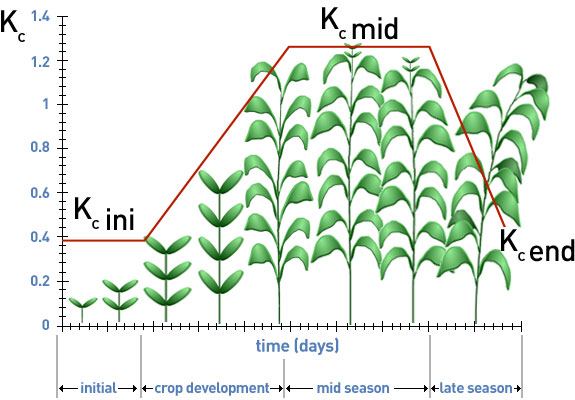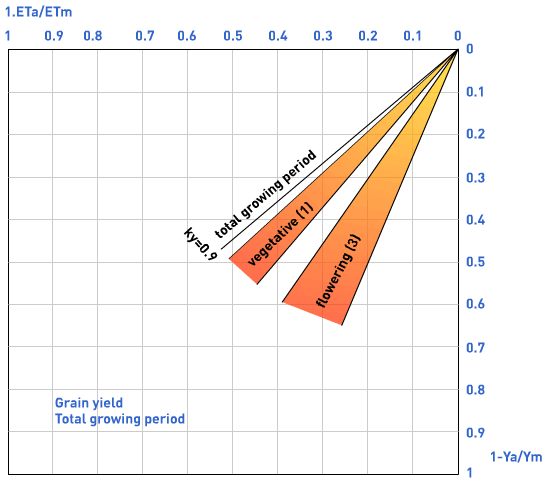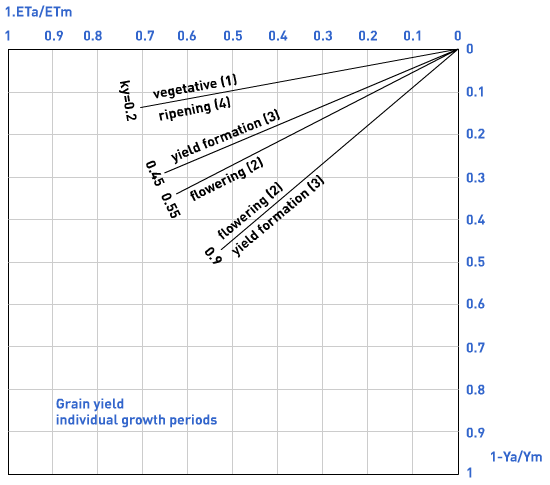Sorghum
This section presents information on water relations and water management of sorghum and provides links to other sources of information.
Crop Description and Climate
Crop Description and Climate
Sorghum (Sorghum bicolor) appears to have been domesticated in Ethiopia about 5000 years ago. Present world production is about 58 million tons grain from 42.6 million ha. (FAOSTAT, 2001).
Sorghum has a number of features which make it a drought-resistant crop. It is extensively grown under rainfed conditions for grain and forage production. In dry areas with low and/or erratic rainfall the crop can respond very favourably to supplemental irrigation. However, considerable differences exist amongst varieties in their response to irrigation and those that are considered very drought-resistant respond slightly while others produce high yields under irrigation but are poor yielding when water is limiting. Temperature is an important factor in variety selection. Optimum temperatures for high producing varieties are over 25°C but some varieties are adapted to lower temperatures and produce acceptable yields. When mean daily temperatures during the growing season are greater than 20°C, early grain varieties take 90 to 110 days and medium varieties 110 to 140 days to mature. When mean daily temperatures are below 20°C, there is an extension of about 10 to 20 days in the growing period for each 0.5°C decrease in temperature, depending on variety, and at 15°C a sorghum grain crop would take 250 to 300 days to mature. With mean daily temperatures in the range of 10 to 15°C, the sorghum crop can only be grown as a forage crop because of the problems with seed set and grain maturity under cool conditions. Low temperatures (<15°C) during flowering and yield formation, and high temperatures (>35°C) lead to poor seed set, problems with ripening and reduced yields.
For optimum light interception the density index (plants per ha s row spacing) is about 3000 when adequate water and fertilizers are available (100 000 to 150 000 plants per ha). In areas where water (rainfall + irrigation) is in short supply, the greater the shortage, the greater is the advantage of wider spacing. Sorghum is a. short-day plant but day-neutral varieties exist.
The crop does well on most soils but better so in light to medium textured soils. The soil should preferably be well-aerated and well-drained. Sorghum is relatively tolerant to short periods of waterlogging. The fertilizer requirements are up to 180kg/ha N, 20 to 45 kg/ha P and 35 to 80 kg/ha K.
Sorghum is moderately tolerant to soil salinity. Yield decrease due to soil salinity under irrigation is: 0% at ECe 4 mmhos/cm, 10% at 5.1, 25% at 7.2, 50% at 11 and 100% at ECe 18 mmhos/cm.
The graph below depicts the crop stages of sorghum, and the table summarises the main crop coefficients used for water management.

Stages of Development | Plant date | Region | |||||
|---|---|---|---|---|---|---|---|
Crop characteristic | Initial | Crop | Mid- season | Late | Total | ||
Sorghum-grain | |||||||
Stage length, days | 20 | 35 | 40 | 30 | 130 | May/June | USA, Pakis., |
Depletion Coefficient, p | 0.6 | >> | 0.5 | 0.8 | 0.55 |
| |
Root Depth, m | 0.30 | >> | >> | 1.4 | - |
| |
Crop Coefficient, Kc | 0.7 | >> | 1.0-1.15 | 0.55 | - |
| |
Yield Response Factor, Ky | 0.2 | 0.55 | 45 | 0.2 | 0.9 |
| |
Sorghum-sweet | |||||||
Stage length, days | 20 | 35 | 40 | 30 | 130 | May/June | USA, Pakis., |
Depletion Coefficient, p | - | - | - | - | 0.5 |
| |
Root Depth, m | - | - | - | - | 1.0-2.0 |
| |
Crop Coefficient, Kc | 0.7 | >> | 1.2 | 1.05 | - |
| |
Yield Response Factor, Ky | - | - | - | - | - |
| |
Water Requirements
Water Requirements
For high production crop water requirements (ETm) of 110 to 130 day sorghum are between 450 and 650 mm depending on the climate; to this the losses during con-veyance and application must be added. The crop coefficient (kc) relating maximum evapotranspiration (ETm) to reference evapotranspiration (ETo) is: during the initial stage 0.4 (20 to 25 days), the development stage 0.7-0.75 (30 to 40 days), the mid-season stage 1.0-1. 15 (40 to 45 days), the late season stage 0.75-0.8 (30 days) and at harvest 0.5-0.55.
Water Supply And Crop Yield
Water Supply And Crop Yield
Following table presents the growth periods of sorghum.
Crop stage | Days | |
|---|---|---|
0 | Establishment, from sowing to head initiation | 15-20 |
1 | Vegetative, from head initiation to head emergence | 20-30 |
2 | Flowering, from emergence to seed set | 15-20 |
3 | Yield formation, from seed set to physiological maturity | 35-40 |
4 | Ripening, from physiological maturity to harvest | 10-15 |
Total | 95-125 | |
The relationships between relative yield decrease (1 - Ya/Ym) and relative evapotranspiration deficit for the total growing period are shown in the figure below.

This figure shows the relationships between relative yield decrease (1 - Ya/Ym) and relative evapotranspiration deficit for the individual growth periods.

Sorghum is relatively more drought-resistant than many other crops, e. g. maize. This is due to an extensive root system, effective control of evapotranspiration and stomata with an ability to recover rapidly after periods of water stress, and an ability to withstand desiccation. Further, where the growing season is long, the tillering varieties are able to recover to a certain extent from water deficits in the earlier growth periods by forming additional head-bearing tillers. Severe water deficits during the flowering period (2) cause pollination failure or headblast. The resulting yield reduction can be partly offset by additional head-bearing tillers.
Sorghum shows a high degree of flexibility toward depth and frequency of water supply because of its drought resistance characteristics. When water supply is limited it may be advantageous to spread available water over a larger area. While yield per unit area will be reduced, water utilization efficiency for yield will be greater resulting in higher overall production in relation to volume of water supplied. The timing of supply should aim at reducing water deficits to a minimum during the establishment (0), flowering, (2) and early yield formation (early 3) periods.
Water Uptake
Water Uptake
The primary root system, with little branching, grows rapidly in deep soils to 1 to 1.5m. The secondary system starts several weeks after emergence and extends rapidly up to 2m, depending on depth of soil wetting. The maximum depth is generally reached at the time of heading. In deep soils the extensive root system allows additional flexibility in irrigation scheduling. Depending on depth and frequency of irrigation, 60 percent (less frequent) to 90 percent (frequent) of the water uptake occurs from the first metre of soil depth. Normally, when sorghum is full grown, 100 percent of the water is extracted from the first 1 to 2m (D = 1-2m). Under conditions when ETm is 5 to 6 mm/day, about 55 percent of the total available soil water can be depleted without reducing water uptake (p = 0.55). During ripening (4) 80 percent can be depleted.
Irrigation Scheduling
Irrigation Scheduling
Where rainfall is not sufficient and irrigation water supply is restricted, irrigation to attain optimum production should be based on avoiding water deficits during the periods of peak water use from flowering (2) to early yield formation period (3). Where water supply will be limited during the flowering period, water savings can be made without causing additional heavy yield losses by reducing water supply during the vegetative (1), late yield formation (late 3) and ripening period (4).
The number of irrigations normally varies between one and four, depending on climatic conditions, and soil texture. The greatest water utilization efficiency will be obtained when these irrigations are well-timed in relation to the sensitivity of the crop to water deficits.
Irrigation is mostly by surface (border, basin or corrugation) method.
Yield
Yield
A good yield under irrigation is 3.5 to 5ton/ha (12 to 15 percent moisture). The water utilization efficiency for harvested yield (Ey) for grain is between 0.6 and 1.0 kg/m3. Grain yield under spate irrigation with little or no rainfall, a total growing period of 90 days with ETm = 425 to 450 mm and net depth applied of about 300 mm, is about 800 kg/ha with a maximum of 1300 kg/ha.

